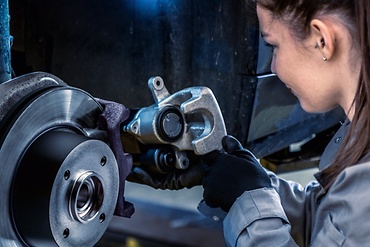Changing brake pads on an HCV disc brake does not present any major challenges for trained mechanics, who should be the only ones carrying out this task. There are still a few fundamental things to take into account, however, in order to avoid premature wear on the pads caused by excessive temperatures.
How-to-guide
After safely lifting the vehicle and dismounting the wheel, you can start changing the brake pads. As always, the first task is a visual check to assess the overall system:
- Condition of brake caliper and brake actuator
- Condition of the cable for wear indication and the ABS sensor
- Condition of the compressed air connections
Now the pistons of the brake caliper have to be retracted manually. Remove the cover cap from the adjuster and turn the adapter below (included as an accessory with the TRW brake pads) anti-clockwise (the “spinning moment” of the overload coupling in the adjuster creates a “click” sound) so that the pistons reveal the inner pad.
Attention: Only turn back far enough until the pistons are in their end position within the brake caliper.
This task already allows first conclusions to be drawn about the condition of the adjuster. If a high level of force is required for turning the adapter, this indicates a defect in the adjuster. The manufacturer defines a maximum torque of 25 Nm for this!
Now you can remove the self-locking pin, the securing bolt and the pad retainer. Move the caliper back and forth to free up the pads and remove these as well.
Note: Skilled mechanics can also assess the condition of the sliding bolts on the caliper during this task. If these are worn and the caliper is therefore hard to move, a repair kit has to be installed. TRW offers suitable kits for most calipers.
In the next step, install the supplied pad springs on the new pads.
Note: Due to ongoing product improvement measures, TRW has changed the design of the pad retaining spring on some pad kits. The new pad retaining spring and the previous TRW or OE pad retaining spring are fully interchangeable!
Also refer to TRW Service Information XZS152.
After checking and thoroughly cleaning the pad slots, insert the new TRW brake pads and install the supplied accessories for securing the pads.
Attention: Never rework the brake pads. Manual reworking of the pads, such as grinding or filing the reverse side of the pad, causes mechanical and thermal overload. This can create unwanted noise or cause the brake caliper guides to become stuck. It reduces the efficiency of the brake and increases wear and noise. Do not make any changes to the brake system!
The subsequent adjustment work is particularly important for the function of the brake later on.
Attention: Fully observe the vehicle manufacturer's information to learn about the correct procedure for the different vehicle types and brake caliper variants!
In our installation test, we carried out the adjustment procedure defined by the manufacturer for this case:
- Turn the adjuster clockwise until the pads touch the brake disc. Do not turn the adjuster too far!
- Then turn the adjuster back by 3 to 4 clicks.
- After actuating and releasing the brake (not shown in the video), it has to be possible to turn the wheel hub by hand.
Then mount the wheel, center it and fix it with the torque defined by the vehicle manufacturer.
After a test drive, check the brake system on an HCV brake test bench.
Service information XZM117i - Please click here to download PDF file
Nice-to-know

ZF Aftermarket product range
Discover the complete portfolio of brakes in our product catalog.

